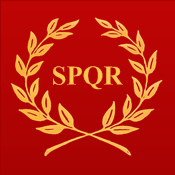Provincia Georgia Florida (Nova Roma)
(→Upcoming Events: added event) |
(→Upcoming Events) |
||
| Line 98: | Line 98: | ||
==Upcoming Events== | ==Upcoming Events== | ||
| − | * a.d. | + | * a.d. XIV Kal. Apr MMDCCLXVII a.u.c (19 Mar 2014), Gulf Coast Society is hosting a celebration for the [http://en.wikipedia.org/wiki/Quinquatria Quinquatria] the ancient Roman festival dedicated to Minerva, at the Cannon Greens on UWF’s campus. Historian Marie-Therese Champagne and Roman bioarchaeologist Kristina Killgrove are planning a fun day of events like mosaic-making, toga-wrapping, and Colosseum-building, interspersed with short talks about Roman food, toilets, burial practices, and religion. To end the day, classical art historian Kara Burns from the University of South Alabama will give a talk on the Roman domus (household). |
==Provincial History== | ==Provincial History== | ||
Revision as of 04:14, 10 January 2014
Provincia
|

|
LUCIUS ULPIUS ATELLUS Legatus pro praetore |
|
The Provincia was organized and created by order of the Senate of Nova Roma on a.d. IX Kal. Nov. 2766 a.u.c. (Oct. 24, 2013) and is one of the numerous Provinciae of Nova Roma, each of which has its own governor and organizes its own events and activities. Nova Roma has much to offer to all those interested in the many facets of Ancient Rome. We have many associations known as Sodalitates which are dedicated to studying a wide range of topics, including but not limited to the Roman military, the Latin Language, and various cultural arts. Provinces hold events to promote membership and encourage participation. Nova Roma is diverse enough to accommodate almost any field of interest in Ancient Rome, including the Religio Romana. For administrative purposes, the provincia is also divided into Regiones, geographically corresponding to modern political districts, each of which is assigned a Legate, who deals with the day-to-day running of his or her Regio. The Provincia is administered by a Governor appointed by the Senate of Nova Roma. The Governor has the power of imperium and can issue edicts (laws on the provincial level). The Governor can also appoint Legati and Scribae. All of these have different titles (see the Cohors Propraetoris). The Provincia is not a self-governing entity, rather it is managed by the Governor who acts according to the will of the Senate of Nova Roma.
PraetoriumThe Praetorium is the office of the governor of a Nova Roman province. The governor is assisted by a staff like that of a present day government. The staff personnel of the Praetorium, the Cohors praetoria, handle areas like the treasury, the military, interprovincial relations, and public games and gatherings. The Cohors Praetoria consists of all the assistants (legati, praefecti and scribae) of the governor. All legati and praefecti are part of the Consilium provinciae, the inner circle of the Cohors. All other officials appointed by the governor are parts of the outer circle of the Cohors. This does not mean that they lack in importance. On the contrary, they each have an important field of responsibility. The whole Cohors is the modern equivalent of the advisors of the provincial Governor of Roma Antiqua. The governor's retinue in antiquity was in many respects a military one, today they are valuable advisors and administrative assistants. As the governors of the old days, the governor expects a certain loyalty, discipline and unity from the Cohors Praetoria. The members of the Consilium Provinciae should, as a kind of General's staff, set an example in this and all Roman behavior to the rest of the Cohors. Legatus pro praetore
Praefecti
Other Staff Members
TABULARIUM PROVINCIORUMEdicta
Propraetor's Annual Report to the Senate
Provincial Blank Forms
Local CommunitiesStart a Local Chapter of Nova Roma TODAY! Citizens are encouraged to establish local communities under the guidance and direction of Nova Roma. Local groups may be formally recognized in two ways. First, a group of five (5) or more citizens may apply for and be granted the status of an Oppidum. Groups consisting of thirty-five (35) or more citizens may apply for and be granted the status of a Municipium. Oppidia and Municipia are self-governing entities, which elect their own Magistrates and Assemblies, and issue their own edicts (edicta) and laws (leges). Leges approved by the comitia of a local community shall have precedence over edicta of local magistrates of that community. Leges of a local community and edicta issued by local magistrates shall take a lower precedence than the constitution and laws of Nova Roma, the senatus consulta of the Senate of Nova Roma, and the decreta of the pontifical and augural colleges of Nova Roma. The actions of local comitia and magistrates shall be subject to intercessio by the Propraetor (provincial governor) and by the Tribuni Plebis and Curule Magistrates of Nova Roma in accordance with the constitution and laws of Nova Roma. Local magistrates shall be considered under the authority of the Governor of the Provincia, and/or as delegated/regulated through his/her Legates (Praefectus/Praefecta Regionis) in terms of authority conflict. For more information on forming an Oppidum or Municipium in your area, contact the Praefectus Regio for your home region or the Governor of the Provincia.
Current ProjectsNone at this time
Upcoming Events
Provincial HistoryThe Provincia was organized and created by order of the Senate of Nova Roma on a.d. IX Kal. Nov. 2766 a.u.c. (Oct. 24, 2013).
Links==Provincial Mailing Lists==
|
Historical Pages > Historical Pages
Master Index
Master Index
Master Index > Maintenance Categories > Pages to be deleted
Master Index > Maintenance Categories > Pages to be deleted > English > Nova Roma > Res publica (Nova Roma) > Magistracies (Nova Roma) > Magistrates (Nova Roma)
Master Index > Maintenance Categories > Pages to be deleted > English > Nova Roma > Res publica (Nova Roma) > Provinciae (Nova Roma) > Former provinces of Nova Roma
Provinciae (Nova Roma)